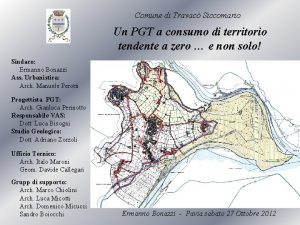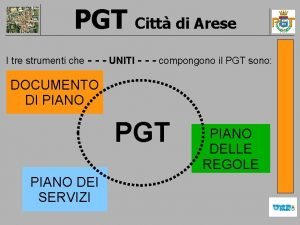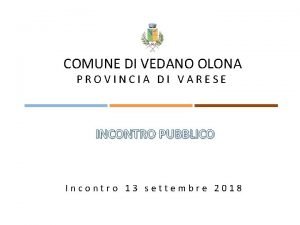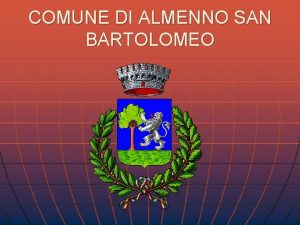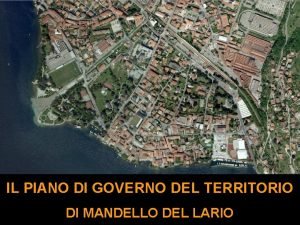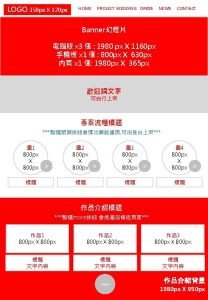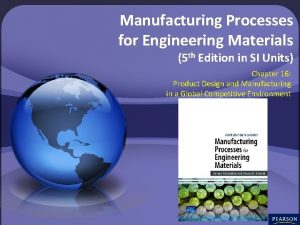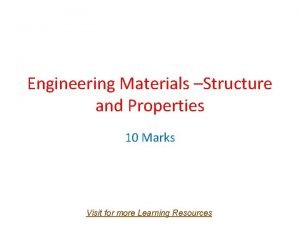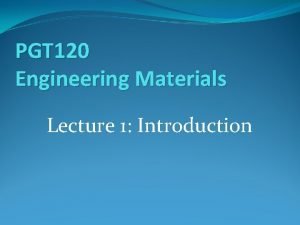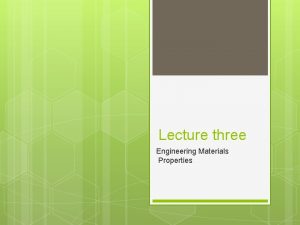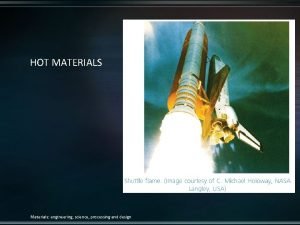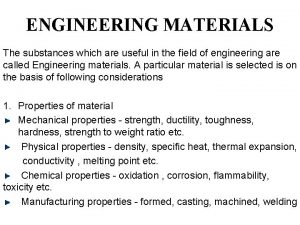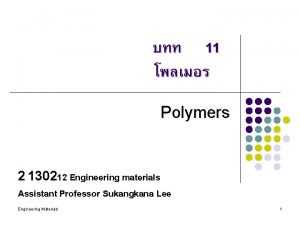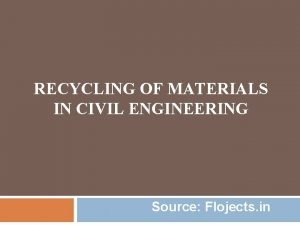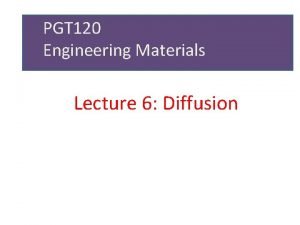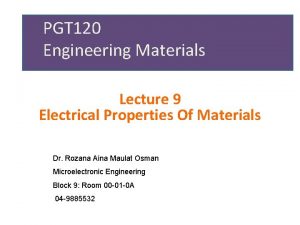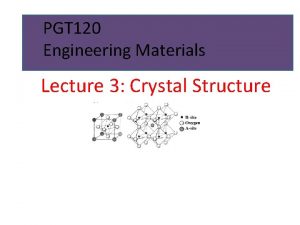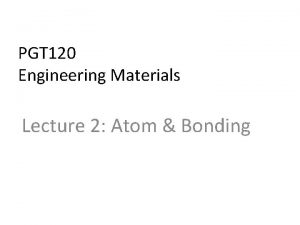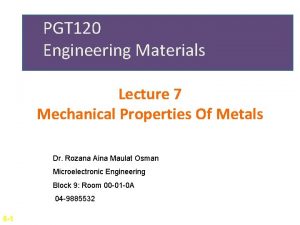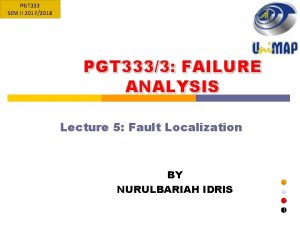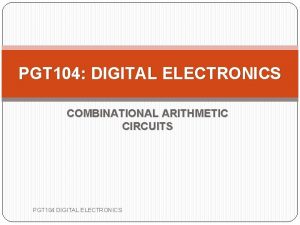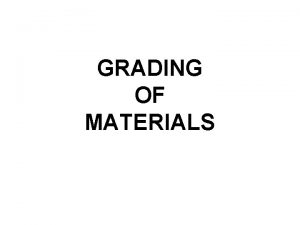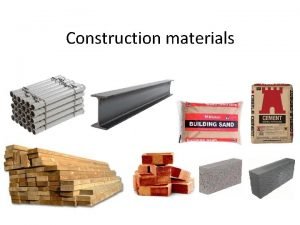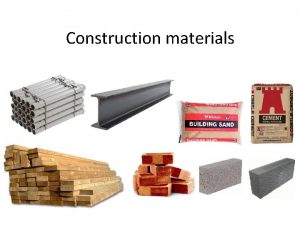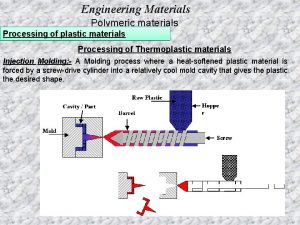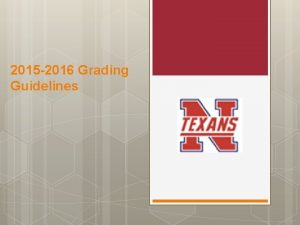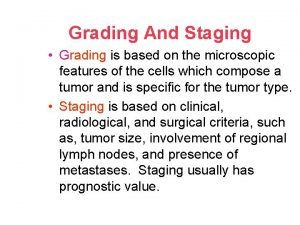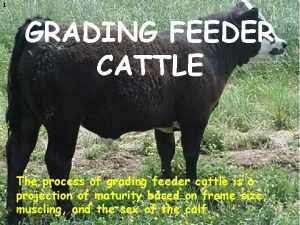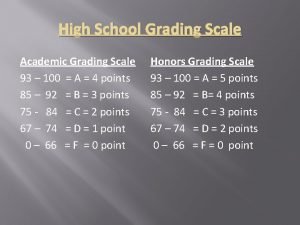PGT 120 Engineering Materials Lecture 1 Introduction Grading
































- Slides: 32

PGT 120 Engineering Materials Lecture 1: Introduction

Grading policies Course work: 40% Assignments = 20% Quizzes = 5% PBL/Viva/activities = 5% Examination: 60% Mid Term Examination Final Examination = 10% = 50%

Course Outcome CO 1: Ability to compare types of material families (metal, polymer, ceramic, and composite) and describe material structure. CO 2: Ability to analyze, calculate, and compare various material characteristic and properties such as mechanical, electrical, magnetic, and optical properties. CO 3: Ability to analyze material reliability in terms of material life cycle, oxidation and corrosion mechanism.

Syllabus Atoms to microstructure Interatomic bonding, structure of crystal, crystal defect, non-crystalline materials Mass transfer and atomic mixing Diffusion, kinetics of phase transformation Mechanical properties Phase Diagram Electrical, thermal, magnetic and optical properties of materials

References Books 1. Foundation of Materials Science and Engineering, William F. Smith and Javad Hashemi, Mc Graw Hill. Material Science and Engineering, William D. Callister and David G. Rethwisch, Wiley. The Science and Engineering of Materials, Donald R. Askeland, Pradeep P. Fulay, Wendelin J. Wright, , Cengage Learning. Physical Chemistry, Ira N. Levine, Mc Graw Hill.

Engineering materials Materials science Investigate relationship between structure and properties materials Materials engineering Designing or engineering the structure to produce predetermined set of properties

Engineering materials Materials are important in engineering in different areas, they are designed: • To support load • To conduct electricity • To accept or reject magnetic • To transmit or reflect light • To save cost • To survive in hostile sorrounding

Materials Types of materials Metals, polymers, ceramics, semiconductor Properties of materials Mechanical, electrical, magnetic, thermal, chemical stability

The development of material over time Metals: copper, tin, bronze, cast, iron, c-steels, alloy steels, aluminum, magnesium, titanium, super alloy, etc. Polymers and Elastomers: wood, fibers, glue, rubber, nylon, epoxies, polyesters, high modulus polymers. Ceramic and Glasses: stone, pottery, glass, cement, fused silica, technical ceramics (Al 2 O 3, Si. C) Hybrids/Composites: paper, metal-matrix composites, ceramic composites.

The evolution of engineering materials with time. Note the highly nonlinear scale. (From M. F. Ashby, Materials Selection in Mechanical Design, 2 nd ed. , Butterworth-Heinemann, Oxford, 1999. )

Class of Materials • • Metal Polymers Ceramics Semiconductor Composite Materials (made by combining two or more of the others) Members of a class have certain feature in common: similar properties (mechanical, thermal electrical, magnetic, and optical properties), similar processing routes, and similar applications.

Metals Composed of one or more metallic elements (Iron, Copper, Aluminum) Metallic element may combine with nonmetallic elements (carbon, nitrogen, oxygen) in relatively small amount. Mechanical Properties: Stiff & strong Ductile (large amount of deformation without fracture) Resistant to fracture. Metallic materials have large numbers of nonlocalized electron. Good conductors of electricity & heat Not transparent

The Golden Gate Bridge north of San Francisco, California, is one of the most famous and most beautiful examples of a steel bridge. (Courtesy of Dr. Michael Meier. )

Polymers Consist of organic (carbon-containing) long molecular chains or network Plastic & rubber materials (Poly vinyl Chloride (PVC), Polyester) Organic compound – carbon, hydrogen & other nonmetallic elements (O, N, Si) Mechanical Properties: Stiffness & strength per mass are comparable to metal&ceramic Ductile & pliable (easily formed into complex shape) Inert chemically & unreactive in large number of environment Tendency to soften and/or decomposed at modest temperature Low electrical conductivity & nonmagnetic

Since its development during World War II, nylon fabric remains the most popular material of choice for parachute designs. (Courtesy of Stringer/Agence France Presse/Getty Images. )

Ceramics Compounds between metallic and nonmetallic elements. They are most frequently oxides, nitrides and carbides Example: aluminum oxide, silicon dioxide, silicon nitride Traditional ceramics: clay minerals, cement, glass Mechanical Properties: Stiff & strong Very hard Brittle (lack ductility) Highly susceptible to fracture. Insulative to passage of heat & harsh environment Optical characteristic – transparent, translucent, opaque Oxide ceramic – exhibit magnetic behaviour

High-temperature sodium vapor lamp made possible by use of a translucent Al 2 O 3 cylinder for containing the sodium vapor. (Note that the Al 2 O 3 cylinder is inside the exterior glass envelope. ) (Courtesy of General Electric Company. )

Composites Compose of two (or more) individual materials (metal, ceramic, polymer) Design goal: to achieve a combination of properties that is not display by any single material & also to incorporate the best characteristic of each of the component. Example: fiberglass – small glass fiber embedded within polymeric material (epoxy/polyester) Mechanical properties of glass fiber: strong, stiff, brittle Mechanical properties of polymer: ductile, weak, flexible Mechanical properties of fiberglass: strong, stiff, flexible, ductile, low density

Overview of the wide variety of composite parts used in the Air Force’s C- 17 transport (From Advance Composites, May/June 1988, p. 53. )

Semiconductor The bonding is covalent (electrons are shared between atoms). The electrical properties depend strongly on minute proportions of contaminants. Silicon, Si Germanium, Ge Gallium Arsenide, Ga. As Gallium Nitride, Ga. N Silicon Carbide, Si. C Silicon is an important electronic material that has triggered computer development revolution. Over the years, integrated circuits have been made with a greater density of transistors located on a single silicon chip with a corresponding decrease in transistor width. These chips play a vital role in computerized manufacturing.

Advanced Materials Electronic materials Superconductor Modern Materials Needs & Future Biodegradable materials Nanomaterials Smart materials

Electronic Materials Not a major type of material, but are extremely important for advanced engineering technology: communication satellites, advanced computers, digital watches, robots, etc. Silicon is the most important electronic material, it is modified in various ways to change its electrical properties.

Future Trends Smart Materials : Change their properties by sensing external stimulus. Ø Shape memory alloys: Strained material reverts back to its original shape above a critical temperature. Ø Ø Used in heart valves and to expand arteries. Piezoelectric materials: Produce electric field when exposed to force and vice versa. Ø Used in actuators and vibration reducers.

Future Trends Ø MEMS: Microelectromechanical systems. Ø Miniature devices Ø Micro-pumps, sensors Ø Nanomaterials: Characteristic length < 100 nm Ø Ø Examples: ceramics powder and grain size < 100 nm Nanomaterials are harder and stronger than bulk materials. Have biocompatible characteristics ( as in Zirconia) Transistors and diodes are developed on a nanowire.

Classification and application of material’s engineering Materials Engineering Examples 1) Metals Vehicle casis, engine jet component, structures (bridge, building, etc) 2) Polymers Liquid Crystal Display (LCD), gasket, computer casing, rubber glove 3) Ceramics Capasitor, varistor, bearing, glass, clay 4) Electronic materials Transistor, diode, light emitting diode (LED), solar sel 5) Biomaterials Replace natural body tissues 6) Composites Fiberglass, aerospace material, golf club shafts, tennis rackets

Variety in materials Image courtesy: Caltech Engineering Design lab handout

Materials in service: wear Photos from a pump repair company homepage (Emnor Mechanical Inc. , Canada)

Corrosion and Oxidation Corroded Titanic bow, rusted baking plate (Image courtesy: wiki)

PROPERTIES COMPARISON Properties / Material Metals Ceramics Polymers Tensile strength High Low High Compression strength Low High Medium Ductility High Low High Electric and thermal conductivity High Low Hardness High Medium Density High Medium Low Elasticity Medium Low High Toughness Medium Low High

A broad classification Based on the specific role in an engineering application • Structural materials (mechanical) • Functional materials (electrical, optical, magnetic, . . . )

Structural versus functional Mylar: good, structurally; bad, functionally undergoes resistive degradation with increasing temperature and humidity) 32 sheets in 0. 45 mm ● Image courtesy: wiki

Structural vs. Functional High Curie Temperature, Tc , oxide ceramic superconductors – BSCCO (bisko) – Bismuth Strontium Calcium Copper Oxide: good, functionally; bad, structurally (brittle) ● Image courtesy: wiki
 Pgt travacò siccomario
Pgt travacò siccomario Pgt martinengo
Pgt martinengo Pgt arese
Pgt arese Pgt vedano olona
Pgt vedano olona Istituto comprensivo almenno san bartolomeo
Istituto comprensivo almenno san bartolomeo Pgt mandello del lario
Pgt mandello del lario 120px x 120px
120px x 120px 100+80+60+40+20
100+80+60+40+20 01:640:244 lecture notes - lecture 15: plat, idah, farad
01:640:244 lecture notes - lecture 15: plat, idah, farad Money-time relationship and equivalence
Money-time relationship and equivalence Requirement analysis in software engineering notes
Requirement analysis in software engineering notes Foundation engineering lecture notes
Foundation engineering lecture notes Descriptive ethics
Descriptive ethics Cant stop the feeling trolls go noodle
Cant stop the feeling trolls go noodle Useful materials that can be found at home
Useful materials that can be found at home Man made map
Man made map Adopting and adapting teaching materials
Adopting and adapting teaching materials Direct materials budget with multiple materials
Direct materials budget with multiple materials Introduction to biochemistry lecture notes
Introduction to biochemistry lecture notes Introduction to psychology lecture
Introduction to psychology lecture Introduction to algorithms lecture notes
Introduction to algorithms lecture notes Manufacturing processes for engineering materials
Manufacturing processes for engineering materials Heat conductivity examples
Heat conductivity examples What is the engineering materials
What is the engineering materials Optical properties of engineering materials
Optical properties of engineering materials Hot materials
Hot materials What is the engineering materials
What is the engineering materials Engineering materials
Engineering materials Materials for engineering
Materials for engineering Integrated computational materials engineering
Integrated computational materials engineering Iit delhi eacademics
Iit delhi eacademics Integrated computational materials engineering
Integrated computational materials engineering Recycling of materials in civil engineering
Recycling of materials in civil engineering
